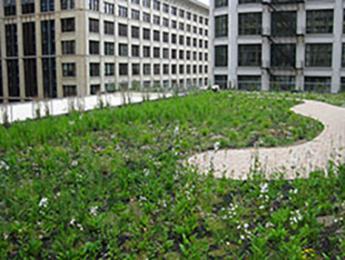
U.S. General Services Administration
A green roof in Chicago.By DANIEL SCHOENHERR
Capital News Service
LANSING – Researchers have found a new way to boost plant growth that could make it easier to cool buildings with rooftop gardens.
It involves biochar, a mix of carbon and ash that is added to soil to prevent erosion, nutrient loss and water loss. Biochar has played a critical role for decades in forest management and agriculture projects.
One trade-off for conventional biochar is it can inhibit plant growth.
“Biochar isn’t too common in the market,” said Nate Griswold, the president of Inhabitect, a Traverse City urban landscaping company focusing on the design and construction of green roofs. Those are rooftop plant beds that naturally regulate building temperature and control water runoff.
Conventional biochar can be used in green roofs, but it’s difficult to obtain enough of the right type for a project. “Supplier A may have the product we need, but Supplier B will often have something different,” said Griswold.
A recent University of Toronto study reported on plants grown in a greenhouse using different types of biochar, including a granulated variant with a larger particle size.
“The results of the study are unprecedented,” said the study’s author, Wenxi Liao. Plants grown with granulated biochar grew 50% to 60% larger than those grown with conventional biochar. They also flowered about two weeks earlier.
A significant advantage is that the granulated biochar’s low density makes it lighter, according to the study. That could allow for larger green roofs, as their size is currently restricted by weight limits for structural reasons.
Griswold said research like this is bringing green roofs closer to universal acceptance for consumers, adding, “Year after year, the industry is growing by multiple times.”
Landscaping companies have already contacted the researchers as they look to incorporate granulated biochar into their soil products, said Liao, a Ph.D. student who researches green infrastructure in the university’s Department of Civil & Mineral Engineering. The substance is affordable and easy to make, but it will take time to begin commercial production.
“Green roofs have been widely promoted as a means to enhance ecosystem services in cities, but roofs present a harsh growing environment for plants,” Liao and two colleagues wrote in a study in the journal Science of the Total Environment.
Green roofs can improve stormwater management and offer ecological benefits, but the problems include biochar’s susceptibility to water and wind erosion and leaching of nutrients, according to the study.
Despite promising test results, the team is alone in their research and doesn’t yet have a complete picture of what’s going on. Liao said she wants to find out why granulated biochar boosted plant performance.
Granulated biochar has its downsides, holding less water than its conventional counterpart.
“More research is needed to increase its benefits,” she said.
The team’s discoveries will help return plants to urban spaces, Liao said. Natural landscapes across the world have been converted into cities, and green roofs promote pollination and reduce local temperatures.
“There is a really brilliant future for green roofs,” Liao said.
Daniel Schoenherr reports for Great Lakes Echo.